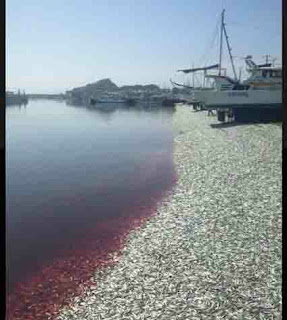Iori Mochizuki, the blogger from Fukushima Diary has published the latest development of the strange phenomena at Osaka Bay in Japan.
It was stated, "the whole bay is actually turning pale yellow" and based on the claims from local residents the same thing happened before The great Hanshin earthquake in 1995 .
The Great Hanshin earthquake, or Kobe earthquake, occurred on Tuesday, January 17, 1995, at 05:46 JST (January 16 at 20:46 UTC) in the southern part of Hyōgo Prefecture and it measured 6.8 on the moment magnitude scale (USGS),and Mj7.3 (adjusted from 7.2) on JMA magnitude scale
The region is near the area of a recent sardine mega-fish kill.
In May of this year, Japanese seismologist warned of the dangers of a tripple-earthquake strike in the area: “If three earthquakes simultaneously occurred along the Nankai Trough located in the seabed off central to western Japan, high-rise buildings in Osaka would be shaken by long-period ground motion five times stronger than that in the Great East Japan Earthquake, researchers have predicted. A group of researchers with the University of Tokyo made the announcement on May 21 at the Japan Geoscience Union Meeting, currently under way in Chiba. The group also speculates that, if the three temblors — the Tokai, Tonankai and Nankai quakes — took place together, high-rise buildings in Tokyo would be shaken by long-period ground motion twice to three times stronger than that in the Great East Japan Earthquake, which struck northeast Japan on March 11, 2011. The long-period ground motion will be stronger in the Tokai-Tonankai-Nankai earthquake because seismic tremors will be amplified by soft rock and stone deposited along the plate boundaries in the Nankai Trough, according to the researchers. The announcement is expected to prompt authorities to step up measures to minimize possible effects on urban areas, which host skyscrapers. In their study, the group predicted the intensity of long-period ground motion in the event that magnitude-8.7 triple earthquakes took place along the Nankai Trough simultaneously. In case of seismic movements with a cycle of six seconds, the seismic velocity would be 250 centimeters per second in Osaka’s bay area — five times that in the Great East Japan Earthquake — and 110 to 165 centimeters per second in central Tokyo. The tremors in both cities would also last at least twice as long as the March 11 quake, according to the researchers.” -DU
I think We should keep a close EYE on this part of the planet in the next few weeks! There is something a foot!


No comments:
Post a Comment